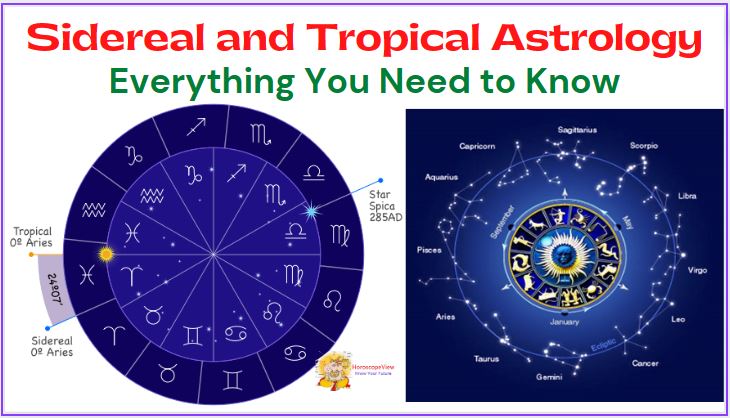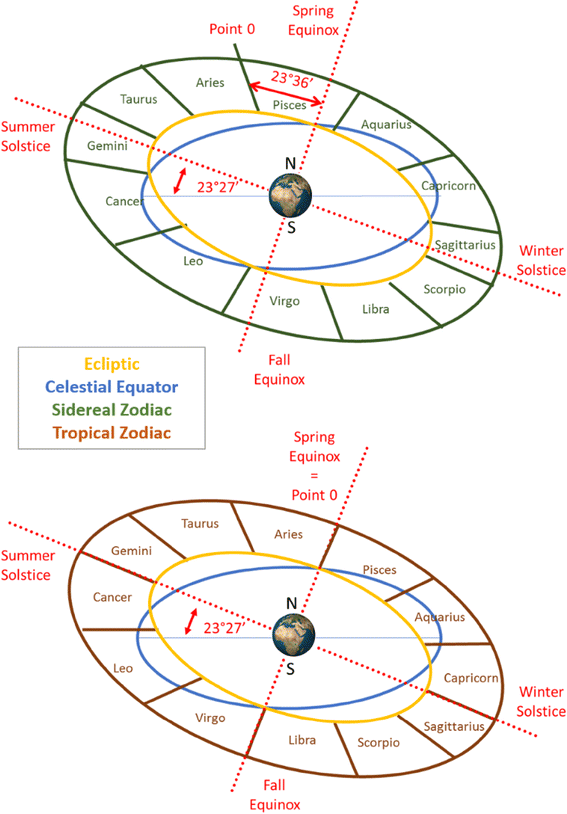Sidereal and Tropical Astrology – It’s really very important to clearly analyze and understand the difference between the two primary systems of astrology. The Vedic or Sidereal, and the Western or Tropical astrology system. Without this clear understanding it’s really very easy to think that one astrology system is superior or inferior to the other and disregard their respective places in the world of astrology and astronomy.
In general, Astrologers use two primary zodiac systems around the world to divine meaning from the cosmos. Those are, sidereal and tropical astrology systems. In both tropical and sidereal systems, the zodiac wheel is divided into 12 zodiac signs.
The primary difference between Sidereal and Tropical astrology systems is where those signs are placed in the sky. The sidereal system is based on the current position of the constellations and the stars while the tropical astrology system is based on where the stars were around 0 AD. In essence, the dates of the sidereal zodiac or astrology change over time and the dates of the tropical zodiac do not.
Sidereal and Tropical Astrology
Below are the short definitions of Sidereal and Tropical Astrology Systems.
Sidereal Astrology
Sidereal Astrology or system observes celestial bodies and takes into account the stars movement in its zodiac chart. Astrologers often refer to these bodies as “fixed stars,” however, Sidereal Astrology recognizes that these stars are not fixed at all as per this system.
Get Your Soulmate Drawing (Exact Image)
Many People Are Shocked To See What Their Soulmate Actually Looks Like.
Sidereal system also recognizes that the Earth sits on a skewed axis, and also further contributes to the changing distance between the Earth and stars. So, the Sidereal Zodiac uses corrective systems, formulas or equations known as ‘Ayanamsas‘ to precisely determine the position of each zodiac sign.
Tropical Astrology
Tropical system is a form of astrology system that measures the position of the sun relative to the vernal equinox. This does not compensate for the precession of the Earth’s axis, therefore, the zodiac signs move around the sky relative to the vernal equinox by about one sign every 2150 years as per research.
The Tropical Zodiac or system is the position of the sun referenced against the earth’s horizon which gives you the seasons as a measure of the flow of time. The framework for the 4 seasons are, 2 solstices and the 2 equinoxes. This is the one most popular and modern western astrologers use.
Sidereal and Tropical Zodiacs
Now the question here is, Why two zodiacs anyway? Isn’t one enough to predict? After all, one sky seems to have worked out well. God made no fault or mistakes there.
One zodiac belt, about 18 degrees wide, with the 12 zodiac signs ranging from Aries – Pisces zodiac sign rising in the eastern horizon. It’s just an astronomical fact. The stars shine equally on everyone, whether they’re standing in New York or London, so why is one “sidereal” zodiac sign popular in the East and one “tropical” zodiac popular in the West?
First of all both zodiacs are strongly and exactly the same in the sense that there are 12 zodiac signs progressing from Aries to Pisces zodiac signs. The elements are fire, earth, air, water; qualities –cardinal, fixed and mutable and general characteristics and nature associated with each zodiac sign are basically the same in both systems.
Up until the last century and so on, before the discoveries of Uranus, Neptune, Chiron and Pluto, the classical rulership’s of the signs were used in both systems. The classical sign rulerships are –
- Mars rules Aries and Scorpio,
- Venus rules Taurus and Libra,
- Mercury rules Gemini and Virgo,
- The Moon rules Cancer,
- The Sun rules Leo,
- Jupiter Rules Sagittarius and Pisces,
- Saturn Rules Capricorn and Aquarius.
The difference between the two zodiacs, so, is not much the content of the zodiac however in the calculation of the timing for the starting point of the 1st degree of Aries zodiac sign.
Related:
source:researchgate
Sidereal vs Tropical
Sidereal and Tropical astrological systems used to describe two different definitions of a year, applied in tropical solar calendars or sidereal solar calendars. They refer to 2 different (astrology) systems of ecliptic coordinates to divide the ecliptic into 12 zodiac signs. Each zodiac sign is divided into 30 degrees, and it is making a total of 360 degrees.
While sidereal astrology systems define the signs that are relative to the apparent backwards of fixed stars movement of about 1 degree every 72 -years from the perspective of the Earth, tropical astrology systems define 0 degrees of Aries zodiac sign to coincide with the vernal point or vernal equinox which also known as the March equinox in the Northern hemisphere.
Sidereal astrology systems maintain the alignment between signs and constellations via corrective systems known as Ayanamsas. In Sanskrit: ‘Ayana’ “Movement” + ‘Aṃśa’ “Component”, to allow for the observed precession of equinoxes, whereas tropical astrology system is based upon the seasonal cycle of the -Northern Hemisphere.
This has caused the two astrological systems, which aligned around 2000 years ago, to drift apart over the centuries.
“Ayanamsa” systems used in Hindu or Vedic astrology include the Lahiri ayanamsa and the Raman ayanamsa. The Fagan Bradley ayanamsa is an example of an ayanamsa -system in Western sidereal astrology.
As of 2020, sun signs calculated using the Sri Yukteswar – ayanamsa were around 23 degrees behind tropical sun signs.
Per these calculations, persons born between March 12th and April 12th, would have the sun sign of Pisces.
By contrast, persons who are born between March 21st – April 19th would have the sun sign of Aries per tropical calculations.
Difference between Sidereal and Tropical
The difference between the sidereal -green / above and tropical zodiac -brown / below as seen from a geocentric earth. The tropical zodiac astrology system entirely sun-based and the signs set upon the -ecliptic. The sidereal zodiac based upon the place / position of the sun in relation to the star constellations as they appear in the night sky that measured in the early morning when the sun rises.
The tropical zodiac system aligns the spring equinox straight onto point 0 of the tropical Aries sign, and the summer and winter solstices fall perpendicular upon it, respectively right between Gemini sing and Cancer and Sagittarius and Capricorn zodiac signs.
Thanks for reading and sharing this guide.




Leave a Reply